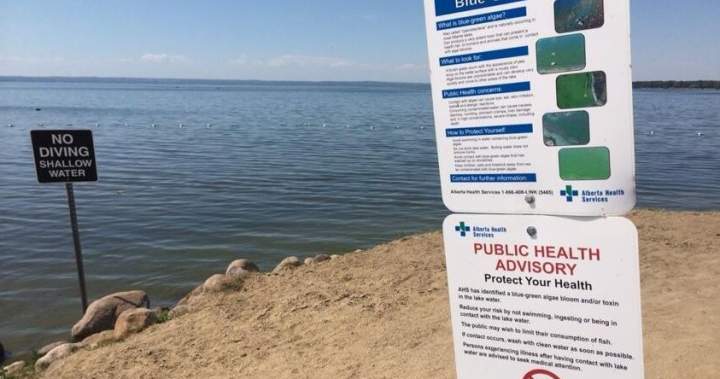The late afternoon sun casts long shadows across Pigeon Lake’s surface as Ted Hellman, a third-generation lakeside resident, peers into the water from his dock. What should be crystal clear has taken on an unsettling greenish hue, with patches of what looks like spilled paint collecting along the shoreline.
“Twenty years ago, this wouldn’t have happened until August, if at all,” Hellman tells me, gesturing toward the suspicious blooms. “Now we’re seeing it in early summer. My grandkids were supposed to visit next week, but I’ve had to tell them to stay away.”
Pigeon Lake residents received alarming news last week when Alberta Health Services issued a blue-green algae advisory, warning the public about potentially toxic cyanobacteria blooms forming in the popular recreational lake. The advisory, which came weeks earlier than in previous years, has disrupted summer plans and raised concerns about the lake’s long-term health.
Blue-green algae, scientifically known as cyanobacteria, occurs naturally in many Alberta lakes but proliferates in warm, nutrient-rich conditions. When these bacteria form visible blooms, they can release toxins harmful to humans, pets, and wildlife. Exposure can cause skin irritation, sore throat, red eyes, swollen lips, fever, nausea, vomiting, and diarrhea. In severe cases, more serious health effects may occur.
“I’ve been tracking these blooms for over a decade,” says Dr. Lorna Munroe, aquatic ecologist with the University of Alberta. “What’s concerning is not just their presence, but their increasing frequency, duration, and toxicity levels. This is consistent with what we’re seeing across prairie watersheds as climate change brings longer, hotter summers.”
The Pigeon Lake Watershed Association has been fighting against these blooms since 2010. Their representatives note that historical practices like clearing natural vegetation along shorelines, using phosphate-containing fertilizers near the water, and inadequate sewage management have contributed to nutrient loading that fuels the blooms.
“This isn’t just an environmental issue—it’s economic and cultural,” explains Susan Holbrook, who operates a small resort on the lake’s eastern shore. She estimates her bookings have dropped 40% since the advisory was announced. “People come here for generations to swim, fish, and connect with nature. When they can’t do that safely, something precious is lost.”
The morning after meeting Hellman, I join Catherine Running Wolf, a member of the Maskwacis First Nation, whose ancestors have harvested from these waters for centuries. We walk along a quiet stretch of shoreline as she points out traditional plants used for medicine and ceremony.
“The water is our relative, not just a resource,” she explains. “When the algae comes, the fish struggle to breathe, the plants can’t get sunlight, and our ceremonies are affected. Everything is connected.”
Alberta Health Services has advised visitors and residents not to swim or wade in areas where blue-green algae is visible, to avoid providing drinking water from the lake to pets or livestock, and to consider limiting human consumption of fish from the lake.
Dr. Malcolm Hayes from Alberta Health Services emphasizes the importance of taking precautions. “Even when the bloom isn’t visible, toxins can persist in the water. People shouldn’t drink or cook with untreated water from the lake regardless of how it looks.”
Climate scientists at Environment and Climate Change Canada have documented rising water temperatures across prairie lakes, creating more favorable conditions for cyanobacteria. Their models suggest these blooms may start earlier and last longer as average temperatures increase, potentially becoming a “new normal” for many Alberta lakes.
The community response, however, demonstrates remarkable resilience. The Pigeon Lake Watershed Management Plan has become a model for collaborative action, bringing together Indigenous knowledge-keepers, scientists, municipal leaders, and residents. Their efforts include restoring natural shoreline vegetation, eliminating fertilizer use near the water, upgrading septic systems, and educating visitors.
Brian McMahon, who chairs the Pigeon Lake Watershed Association, remains cautiously optimistic. “We’ve seen improvements when everyone does their part. The lake wants to heal—we just need to give it the chance.”
Back at Ted Hellman’s property, he shows me old photographs of crystal-clear water and children splashing from the very dock where we stand. Then he points to a newly restored section of his shoreline where native plants have replaced what was once a manicured lawn.
“It’s not just about what the government or scientists do,” he reflects. “It’s about changing how we live with the lake. My grandparents took from it without understanding the consequences. Now my responsibility is to give back.”
As twilight settles over Pigeon Lake, the immediate crisis of toxic algae exists alongside a deeper story about how communities adapt to environmental change. The early warning this year has disrupted summer traditions, but it has also catalyzed conversations about stewardship that span generations and cultures.
The path forward for Pigeon Lake—like many watersheds experiencing similar challenges—will depend on this delicate balance between human needs and ecological health, traditional knowledge and scientific innovation, immediate action and long-term vision.
For now, the community waits for test results and cooler temperatures that might break the cycle of algal growth, hoping that their ongoing restoration efforts will eventually lead to healthier waters where children can safely swim again.






